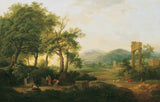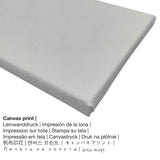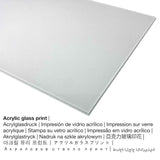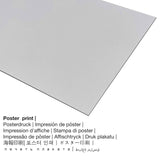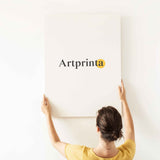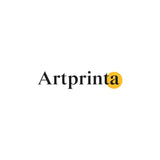Carl Philipp Schallhas, 1796 - Arkadijski pejzaž - likovni tisak
Porez je uključen. Dostava obračunata na blagajni.
Detaljan opis umjetničkog proizvoda
Ovo više od 220 staru sliku naslikao je muški Mađarski slikar Carl Philipp Schallhas in 1796. The original measures the size - 87 x 135 cm - frame: 108 x 154 x 10 cm and was crafted with the techinque of ulje na platnu. Signed and dated lower left on the stone: P: Schallhas. 1796 was the painting's inscription. This work of art belongs to the collection of belvedere. The klasična umjetnost javnosti umjetničko djelo je pruženo ljubaznošću © Belvedere, Beč, inventarni broj: 5451. Štaviše, umjetničko djelo ima kreditnu liniju: exchange with Hermann Knaus, Vienna in 1961. Povrh toga, poravnanje je unutra pejzaž format s omjerom 3: 2, which means that the length is 50% longer than the width. The painter Carl Philipp Schallhas was an artist from Hungary, whose style was mainly Classicism. The artist lived for a total of 30 godina - rođeni godine 1767 in Bratislava, Bratislavsky, Slovakia and deceased in the year 1797 in Vienna, Vienna state, Austria.
Odaberite materijal koji biste željeli imati
Za svaki proizvod nudimo različite veličine i materijale. Stoga vam omogućavamo da odaberete između sljedećih opcija:
- Štampanje postera (materijal na platnu): A poster is a printed sheet of canvas paper with a slightly rough finish on the surface, that reminds the actual work of art. It is optimally qualified for framing your art replica using a custom frame. Please note, that depending on the absolute size of the poster we add a white margin of approximately 2-6cm round about the painting, which facilitates the framing with a custom frame.
- Otisak akrilnog stakla: An acrylic glass print, which is sometimes referenced as a print on plexiglass, changes the artwork into lovely décor. Above all, the acrylic glass art print is a distinct alternative option to canvas and dibond art prints. Your own copy of the artwork is printed with the help of state-of-the-art UV print technology. It creates sharp and rich colors.
- Aluminijski dvobojni otisak: An Aluminium Dibond print is a material with a true effect of depth. A direct Aluminium Dibond Print is the perfect start to art prints with aluminum. The colors are luminous, the details appear crisp and clear.
- Platno: A canvas print, not to be confused with a painting on a canvas, is an image printed from an industrial printing machine. A canvas print has the advantage of being low in weight, which implies that it is quite simple to hang your Canvas print without the use of additional wall-mounts. Canvas prints are suited for any type of wall.
Disclaimer: We try what we can in order to depict our products as exact as possible and to exhibit them visually on the different product detail pages. At the same time, the tone of the printing material and the imprint may differ somehwat from the representation on the screen. Depending on your screen settings and the condition of the surface, colors might not be printed 100% realistically. Bearing in mind that all art reproductions are processed and printed manually, there might also be minor variations in the size and exact position of the motif.
Specifikacije proizvoda
| Ispiši kategorizaciju: | umjetnička reprodukcija |
| Reprodukcija: | digitalna reprodukcija |
| Način proizvodnje: | digitalni tisak (UV direktni ispis) |
| produkcija: | proizvedeno u Njemačkoj |
| Vrsta zaliha: | proizvodnja na zahtjev |
| Predložena upotreba proizvoda: | dizajn kuće, zidni dekor |
| Poravnanje slike: | poravnanje pejzaža |
| Odnos strane: | 3: 2 (dužina: širina) |
| Tumačenje omjera: | dužina je 50% duža od širine |
| Dostupne tkanine proizvoda: | metalni otisak (aluminijski dibond), otisak plakata (platneni papir), akrilni stakleni otisak (s pravim staklenim premazom), otisak |
| Mogućnosti veličine otiska na platnu (platno na okviru nosila): | 30x20cm - 12x8 ", 60x40cm - 24x16", 90x60cm - 35x24 ", 120x80cm - 47x31", 150x100cm - 59x39 " |
| Varijante akrilnog stakla (sa pravim staklenim premazom): | 30x20cm - 12x8 ", 60x40cm - 24x16", 90x60cm - 35x24 ", 120x80cm - 47x31" |
| Opcije veličine štampe plakata (papir na platnu): | 60x40cm - 24x16 ", 90x60cm - 35x24", 120x80cm - 47x31 " |
| Varijante aluminijumskog dibonda: | 30x20cm - 12x8 ", 60x40cm - 24x16", 90x60cm - 35x24 ", 120x80cm - 47x31" |
| Ram za sliku: | reprodukcija bez okvira |
Komad umjetničkih informacija
| Naziv umetničkog dela: | "Arcadian landscape" |
| Kategorizacija: | slika |
| Široka kategorija: | klasična umjetnost |
| period: | 18th stoljeća |
| Godina rada: | 1796 |
| Starost umjetničkog djela: | oko 220 godina |
| Slikano na: | ulje na platnu |
| Originalna veličina: | 87 x 135 cm - okvir: 108 x 154 x 10 cm |
| Potpisano (umjetničko djelo): | signed and dated lower left on the stone: P: Schallhas. 1796 |
| Muzej: | belvedere |
| Lokacija muzeja: | Beč, Austrija |
| Web stranice: | belvedere |
| Vrsta licence za umjetničko djelo: | javnosti |
| Ljubaznošću: | © Belvedere, Beč, inventarni broj: 5451 |
| Kreditna linija umjetničkih djela: | exchange with Hermann Knaus, Vienna in 1961 |
Detalji o izvođaču
| Ime izvođača: | Carl Philipp Schallhas |
| Poznat i kao: | Schallhas Karel Filip, Schallhes Karol Filip, schallhas c., c. ph. schallhas, c. schallhas, schallhas, karl philipp schallhas, Schalhas CarlPhilipp, Carl Philipp Schallhas, Schalhaas Carl Philipp, c. p. schallhas, Schallhas Carl Philipp |
| Pol izvođača: | muški |
| Nacionalnost umjetnika: | Mađarski |
| Zanimanja umjetnika: | slikar |
| Zemlja porijekla: | Mađarska |
| klasifikacija: | stari majstore |
| Styles: | Klasicizam |
| Preminuo u dobi: | 30 godina |
| Godina rođenja: | 1767 |
| Mjesto rođenja: | Bratislava, Bratislavsky, Slovakia |
| Umro u godini: | 1797 |
| Grad smrti: | Beč, država Beč, Austrija |
© Autorska prava od | Artprinta.com
Original information about the work of art by Belvedere website (© - Belvedere - www.belvedere.at)
During his studies of landscape painting at the Vienna Academy was Carl Philipp Schallhas excited (1722-1795) to illustrate his own observations of nature in the image of his teacher Johann Christian Brand. The young painter specialized in the wake of the Vedute, the sights painted along the Danube in the Wachau and gave 1791 a series of 18 colored etchings from around Vienna out ( "painted and landscape from nature etched" with the subtitle) , Only occasionally can be found in his oeuvre representations of imaginary landscapes, and then only as drawings and prints (Vienna, Albertina Graphic Arts Collection, Budapest, Szépmüvészeti Muzeum). This view is probably the only oil painting of this genre. Ideal landscapes as they were to the 19th century, painted, can be primarily from the works of Nicolas Poussin's (1594 to 1665) and Claude Lorrain (1600 to 1682) derived, with Poussin's Landscape view was an "ideal-heroic" those "classical ideal" of Lorrain in Arcadian shape. The essence of the ideal or Arcadian landscape is any assembly of individual parts of the image into a harmonious whole. Ruins of ancient buildings give an indication of the former size of the tract of land and let wistful reminiscences about. The Schallhas'sche landscape leads us into a wide, bounded by mountains valley. On the right hand side you see dilapidated buildings of different styles of music left, however, only trees that stand out in silhouette against the light of the setting sun. Around the fountain (the source is to be interpreted as a giver of life), people have gathered to feast on the water; in the distance a shepherd playing his flute. The shaded foreground, details of which are finely and precisely worked out is still very committed in his opposition to the delicately lit area behind the baroque image composition in terms Salomon Gessner (1730-1788). However Schallhas achieved in the light guide and into the uniform light color unification of these two areas. H. Aurenhammer saw in the indicated "juxtaposition of idyll and pathos the Human-Small in contrast to the Great Nature" and refers to the moment of transition, from the "ruins, which are almost back to become natural" way to "limiting in the boundlessness of a sunset is losing Tales" enough. Schallhas is with this view but already at the end of a tradition that wants to imagine the realm of gods and myths. His characters do not occur more "idyllic" on, there are people in contemporary dress, which are integrated into a genre-like scene and consistent with the mood of the landscape in harmony. Literature: Wurzbach 29/1875; H. Aurenhammer, A landscape of Goethe's time by Carl Philipp Schallhas in: Releases the Austrian Gallery, the fifth born (1961), No. 49, pp 11ff [Sabine Grabner, in:.. Grabner, Sabine Romantic Classicism Biedermeier (in the Austrian Gallery Belvedere), 2nd revised edition, Vienna 1997, p 40f]

